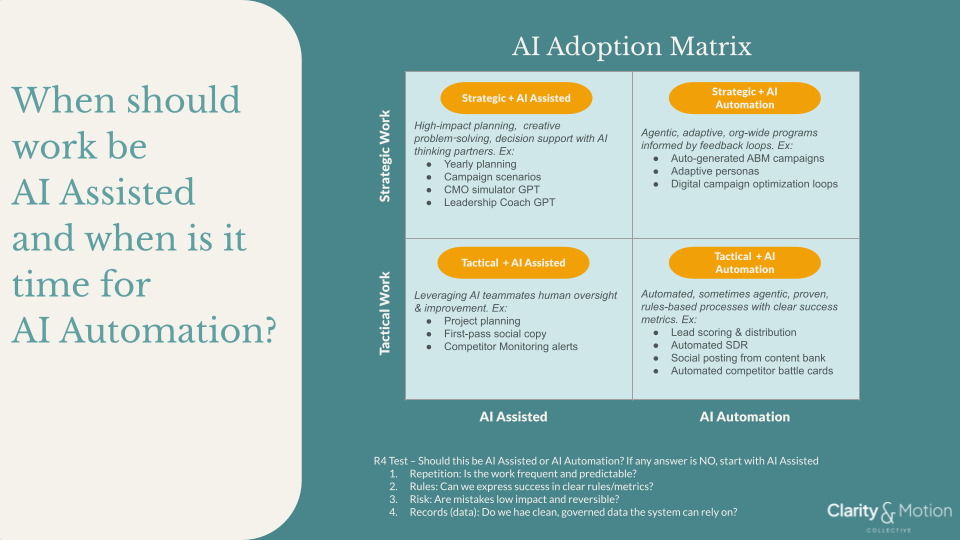AI Readiness: The 4 Dimensions Every GTM Team Must Address
Share this post
Earlier this week, my co-founder Carol-Lyn Jardine wrote about the rush to automate. She called out a pattern we keep seeing: GTM teams sprinting toward AI tools before they’ve built the foundation to succeed.
Here’s what we want leaders to understand: Readiness isn’t a checkbox. It’s a spectrum. And the gaps are often hiding in dimensions most teams haven’t even mapped
A Familiar Pattern
In dozens of conversations with GTM leaders, the same issues keep surfacing:
- Tech-rich, adoption-poor. Some teams have enviable AI stacks, but adoption sits at 10–15%. People go rogue with personal ChatGPT accounts. Reporting is still stitched together in Excel.
- People-ready, data-chaotic. Other teams have buy-in and excitement, but their data is spread across several systems, half of it inaccurate. They’re essentially asking AI to spin gold out of “test@test.com” records and customer segments labeled “startup-ish.”
There are countless variations, but the pattern is the same.
The result is that teams succeed in one or two dimensions of readiness but miss others. It’s like building a house with premium materials, but no blueprint, shaky foundations, and a crew that’s never built a house before.
.png?width=800&height=800&name=Untitled%20(800%20x%20800%20px).png)
The 4-Dimension Framework
At Clarity & Motion Collective, we’ve developed a readiness spectrum across four interdependent dimensions.
1. Process Readiness
Workflows need to be documented, repeatable, and scalable and not just stored as institutional knowledge.
We’ve heard teams talk about “clear processes.” In reality, many rely on a patchwork of exceptions buried in people’s heads: opportunities routed differently depending on which CRM field was filled in, which integration synced last, or who noticed a Slack ping first. On paper it looks sophisticated; in practice, it’s still muscle memory dressed up in tools.
You can’t automate chaos. You can only amplify it.
Signs you’re not process-ready:
- New hires take 3+ months to onboard into basic workflows.
- Different team members describe the same process differently.
- Fear spikes when one “lynchpin” employee takes PTO.
2. People Readiness
Teams need to see AI as a partner and be equipped with the skills and mindset to work with these tools, not around them.
We’ve seen sophisticated teams run well-structured pilots that stalled not because of resistance, but simply because the team hadn’t yet grasped AI’s potential to amplify their work or how to leverage it as a team.
When people experience AI as an amplifier helping them focus on what is most strategic and stripping away mundane tasks the mindset shift is powerful.
Signs you’re not people-ready:
- AI tools sit unused despite training.
- Teams invent workarounds rather than using AI features.
- “That’s not how we do things here” is a common refrain.
- Teams use AI for glorified search rather than as a true thinking partner.
3. Tech Readiness
Is your stack integrated, or duct-taped together with CSV exports?
Is your tech stack integrated or duct-taped together? Most marketing tech stacks weren't purposely built, they were accumulated over time. Teams add layers of tech to solve a problem, but haven’t zoomed out to see how their current stack fits together. We've seen teams spend more time moving data around than using it.
Signs you’re not tech-ready:
- “Single source of truth” is an inside joke.
- Paid-for tools sit idle, forgotten.
- API limits dictate your workflows.
4. Data Readiness
Is your data clean, accessible, and trustworthy, or a patchwork of best guesses?
On the surface, many modern GTM teams appear to have clean CRMs and fairly mature operations. But under the hood, critical fields are often inconsistent across systems, customer data lives in disconnected silos, and key attributes aren’t structured in ways that AI can actually use. The issue usually isn’t a lack of data,it’s that the data isn’t AI-ready. Garbage in, garbage out, except now it’s garbage at scale.
Signs you’re not data-ready:
- Data silos block end-to-end visibility across Marketing, Sales, and Product.
- Key data objects (like customer or opportunity) are defined differently across systems.
- Dashboards contradict each other on the same metric, eroding trust in reporting.
Why These Dimensions Are Interconnected
You can’t fix one dimension in isolation. They’re deeply interdependent.
- An automated process fails if people don’t adopt it.
- The best tools fail on dirty data.
- Clean data is useless if trapped in silos.
- Enthusiastic people can’t overcome broken processes.
AI readiness is a system. And systems thinking is what’s missing from most adoption strategies. But you also don't need to take it all on to start a successful and effective AI transformation. This is where clarity and motion come in: clarity to see the system as it is, and motion to take the next step forward without waiting for perfection.
MIT's research shows that external partnerships succeed 66% of the time versus 33% for internal builds—not because external tools are inherently better, but because partnerships force organizations to clearly define processes, data requirements, and success metrics before implementation.
The Path Forward: Clarity First, Motion Next
If you’re thinking, “We’re weak in all four dimensions, are we doomed?” The answer is no. But the path forward starts with a mindset shift:
Stop thinking of AI readiness as a destination. Start thinking of it as a practice.
The teams that succeed don’t wait until they’re “100% ready.” They make an honest assessment of where they are, pick the weakest link, and begin building through motion, step by step, with clarity (a roadmap based on an honest assessment - guiding the way. Because clarity on where you are is the key to the AI strategy you need. This honest assessment also opens us the opportunity to leverage AI to solve some of these problems.
Quick Wins to Build Momentum
- Strong in tech, weak in people: Start with a small, visible win. Automate a hated manual task. Celebrate publicly. Build trust through proof.
- Strong in people, weak in process: Channel enthusiasm into process sprints. Let the team document. They’ll build better systems than any consultant.
- Strong in process, weak in data: Launch a “data amnesty.” Clean one critical object completely, often “customer” or “lead.” Make it gold standard, then expand.
- Strong in data, weak in tech: Don’t add more tools. Sunset one. Strengthen integrations between the rest. Your stack should get simpler, not more complex.
Making the Mindset Shift Real
Mindset shifts don’t happen in off sites; they develop through daily work.
Here are two recent examples. One started with a Friday afternoon experiment. A team was burning weekends assembling reports - they estimated that they were working at least 4 hours a weekend to get the report down and ready to ship first thing on Monday morning. In two hours, we used AI to cut the time by 75%. Not perfect. Not scalable. Just better. That “small win” created curiosity. Curiosity drove experimentation. Experimentation built capability. Capability created confidence. That process is now fully automated.
Another started with two senior leaders spending 5+ hours a week researching partner inquiries. In 30 minutes, we built a repeatable AI solution that flagged the best-fit partners in green. Hours saved each week. A small project, but again it created curiosity, which led to experimentation, capability, and confidence.
That cycle is what we mean by clarity first, motion next.
Your Next Move
Map where you are. Be brutally honest about your gaps. Then commit 30 days to focused improvement in your weakest dimension.
And don’t do it alone. The teams that succeed make readiness a shared mission, not a mandate.
AI readiness isn’t really about the AI at all. It’s about building GTM teams that can adapt, learn, and evolve with whatever comes next.
That’s the readiness that matters.



